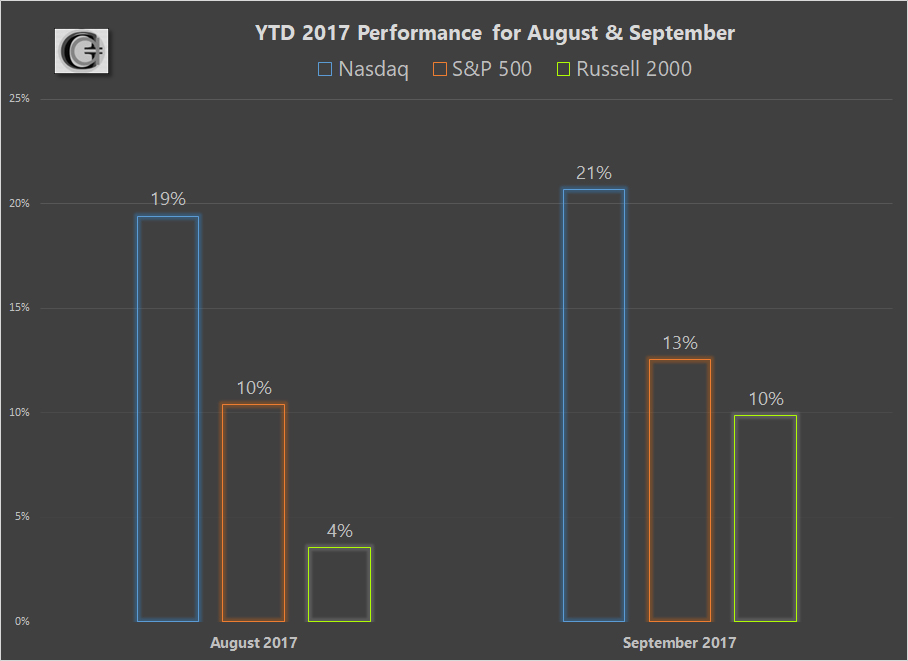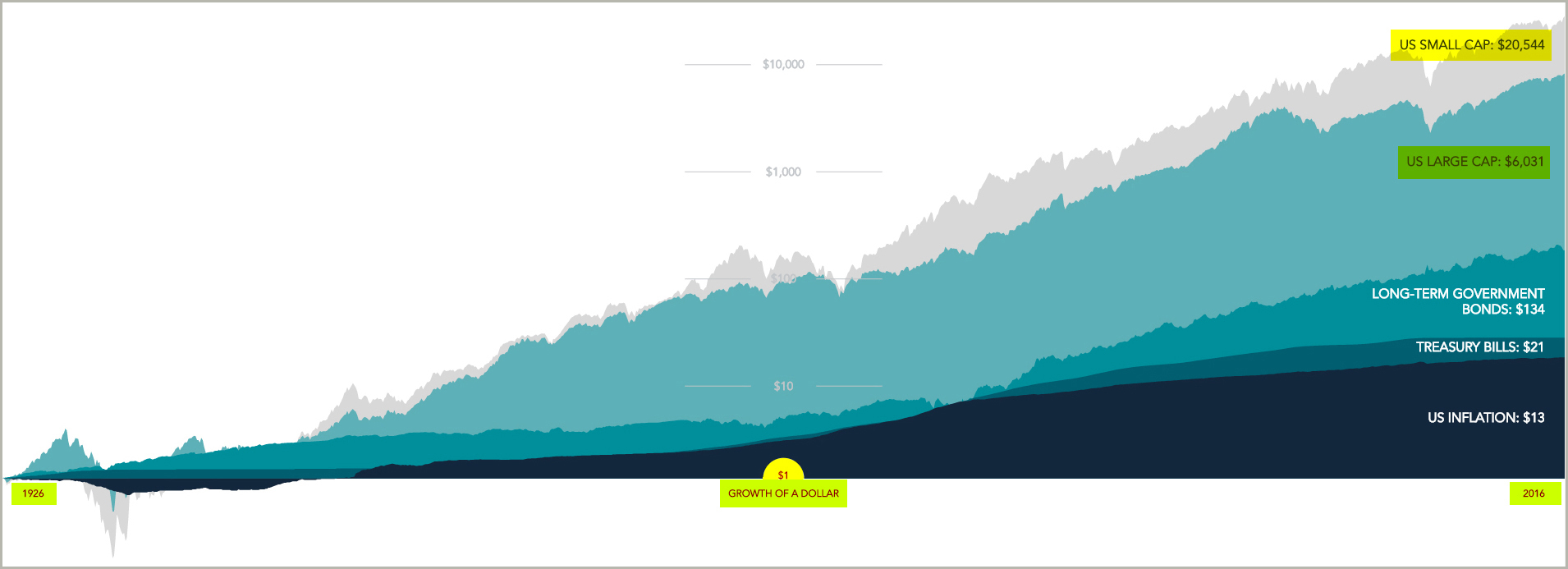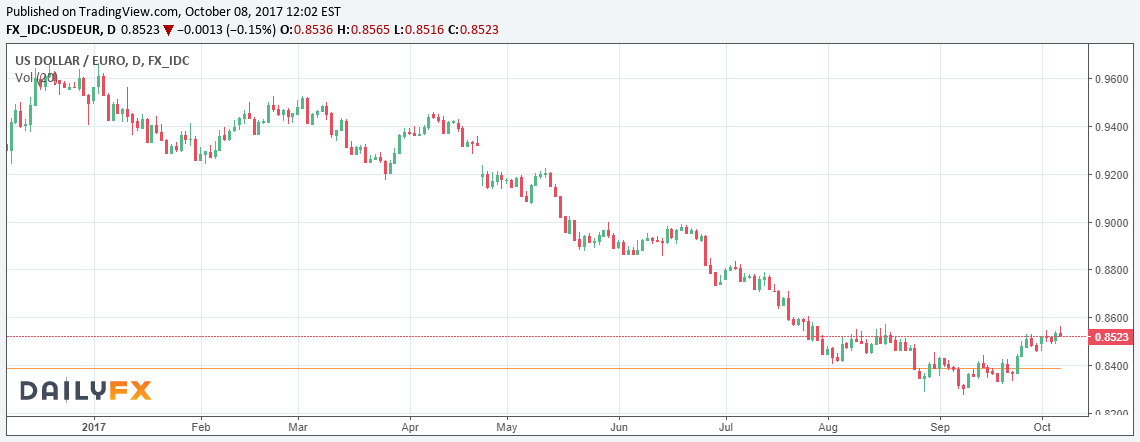October 10, 2017
- After a sleepy start, small cap stocks have turned up the heat.
- Corporate tax cut proposal triggered the rally.
- The enduring power of small cap relative outperformance presents a compelling investment case for long-term investors.
- Small cap stocks still lag the broader market indexes and there is room for small caps to accrue further gains this year.

Small Cap Pulse
Small Cap stocks ignited last month after a tepid start to the year.
Interestingly, the small cap performance in 2017 is beginning to mirror 2016, when the small cap stocks were barely above neutral at mid-year, but then surged in the second half to close out the year with a +19% gain, powering our Graycell Small Cap Model Portfolio to a +71% gain.
At the beginning of September 2017, the Russell 2000 Small Cap Index (IWM) was up 4% for the year and the Graycell Small Cap Portfolio was up +34%. By end of September, in a month's time, the Russell 2000 benchmark had soared to a gain of +10% for the year.
As can be observed from the chart above, small caps continue to lag this year, even though the performance gap with larger cap indexes S&P 500 (SPY), Nasdaq Composite (QQQ) and Dow Jones Industrials (DIA) has narrowed.
Enduring Power of Small Caps
Boosts Case for A Stable Portfolio Allocation
Small-cap stocks are generally defined as companies with a market capitalization of between $250 million to $2 billion.
However, the Russell 2000 index, the most popular small cap benchmark used by asset management institutions, does not use a market cap cutoff. Instead, the Russell 2000 index comprises the smallest 2000 companies in the Russell 3000 index, which in turn, comprises the largest 3000 US publicly-held companies representing 98% of the US stock market capitalization. Consequently, the average market cap and the market cap range of the Russell 2000 changes based on the overall market performance till June of each year when the index is reconstituted. As of the end of September quarter, the average market cap of Russell 2000 was $2.2 billion, the median (midpoint) was $850 million, and the highest market cap stock was $10 billion, which we believe most likely was Kite Pharmaceuticals (KITE) following its acquisition by Gilead Sciences (GILD).
The Graycell Small Cap Portfolio uses a market cap range of $200 million to $3 billion in its model portfolio.
There has been abundant research over the years providing empirical evidence for the outperformance of small caps on both an absolute and risk-adjusted basis over time.
The work of Nobel laureate Eugene Fama and many others have quite decisively concluded the outperformance of small cap companies compared to larger caps. The outperformance of small cap stocks over larger caps to an extent depends on time frames, whereby in some periods small caps may outperform while underperforming in others. However, when measured over an extended period of time, the small cap outperformance is abundantly clear and consistent.
This outperformance of small caps versus large caps is quite vividly captured in the chart below which demonstrates the growth of $1 in various financial instruments from 1926 to 2016.
If investors are willing to bear the additional volatility and periodic underperformance of small cap stocks in the short-term, then over the long-term they are well compensated for the additional risk, compared to other financial market investments.
It would have been great if an investor simply could rinse off the small cap risk while just expecting the small cap higher return. But that is not possible. Consequently, a prudent small cap portfolio approach must be considered to overcome some of the unique risks while further improving the already higher small cap index returns.
Why The Recent Small Cap Rally And Where Is It Heading?
The onset of the rally in small caps last month was triggered by the tax cut proposal in early September, which has now become the next policy focus of the White House and Republican Congress.

Although the tax cut proposal will probably get modified, any corporate tax cut, in general, is good for small caps. Since most if not the entire income for small caps is generated in the US, they are more likely to pay a relatively higher effective tax rate as opposed to a larger cap company with international income that is not repatriated and thus avoiding taxation.
In addition, a proposed tax holiday on repatriated income can indirectly benefit small caps as they become acquisition targets for larger companies flushed with repatriated cash on their balance sheets
The lagging performance of small caps compared to larger caps this year can be partly explained by the weakening dollar. As can be observed from the chart below, the US dollar which has declined against major currencies has slipped over 10% this year against the Euro.
A weaker US dollar boosts export earnings for larger caps while not conveying any earnings benefit for small caps, which can lead to a relative underperformance of small caps.
Small caps now have momentum.
But will they continue to perform well?
There are reasons which suggest that small caps can continue to accrue further gains this year.
The key reason is that the trigger event, tax reform, will continue to make progress for the remainder of the year and culminate in a legislation by early next year and perhaps even this year due to the urgency for Republicans to show a major legislative victory in 2017. The promise of tax cuts should continue to provide support for small caps as further detailed in the article, Move Over Yellen, It's Tax Cut Time!
Tax cuts in any shape or form will bolster small caps.
Second, small caps are still lagging the other major market indexes, particularly the Nasdaq.
Third, presently there is no risk-averseness that is developing in the market which can hurt speculative segments.
Finally, the broader market remains in an uptrend with generally supportive Economy, Earnings, and Monetary Policy. We have talked earlier about the sharpening monetary policy in the article, Will the Federal Reserve Send the Market Higher. But that risk appears restrained for now.
At the same time, there is an interesting perspective offered last week by ETF provider Wisdom Tree, which has referred to the small cap rally as low-quality. Comparing the small cap rally in 2016 to the one in 2017 so far, the institution discovered that weaker segments of the small cap universe - ones without earnings and dividend - have performed better compared to the stronger segments - ones with earnings, dividends, and a stronger historical ROE.
We believe this perceived lack of "quality" rally suggested by the ETF provider can be explained to some extent by the surge in Biotechnology (IBB) (XBI) and emerging growth stocks that have either negative earnings or do not distribute their earnings in the form of dividends. As many investors are aware, Biotechnology is a strongly performing sector this year for a variety of reasons, as discussed in Biotech Bonanza: A Key Piece Falls In Place. A majority of biotechs are small caps.
Conclusion
Small caps have momentum at this point.
But the principal reason to consider a consistent portfolio exposure to small caps is their enduring power to relatively outperform other stock market segments over time. The additional return can make a very substantial impact over the long term, as conveyed by the $1 Growth Chart above.
A disciplined strategy is essential to positioning a small cap portfolio for success and outperformance. Be prepared for volatility as that is inherent in the stock market and even more so in small cap performance. Once an investor has taken care of managing the downside, as much as is practically possible, the upside takes care of itself over time. The return performance over many years in the Graycell Small Cap Portfolio has been based with that philosophy in mind.
With biotech being one of the leading small cap sectors, one is bound to have a few biotech stocks in a small cap portfolio. Some of the promising small cap names, across different industries, include, Kronos Worldwide (KRO), Kemet (KEM), Weight Watchers (WTW) Chegg (CHGG), Esperion Therapeutics (ESPR), Dynavax Technologies (DVAX), Arena Pharmaceuticals (ARNA), Mirati Therapeutics Inc (MRTX), Sangamo Biosciences (SGMO), Abeona Therapeutics (ABEO), MyoKardia (MYOK), Westport Innovations (WPRT), Ultra Clean Holdings (UCTT), Glycomimetics (NASDAQ:GLYC), and Insmed (INSM). And in this market, the list can go on.
As always, kindly do your own due diligence.
The article was first published on Seeking Alpha.




